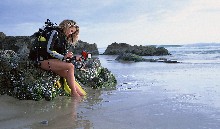|
What is Ocean Culture?
|
A culture is a way of life including the customs, beliefs, values, technology and social institutions shared by a social group or society. Cultures are learnt and are therefore dependent on transmission or communication; they differ from group to group and change over time.
Many cultures have been influenced through association with the sea, hence the term Ocean Culture. |

A small island in the Pacific |
Here we concentrate largely on cultures of Oceania and Australia. Oceania encompasses the islands of the tropical and sub-tropical Pacific Ocean, including those broadly assigned to Polynesia, Melanesia and Micronesia. The term Oceania indicates the dominant role of the ocean in this area. For example, the ocean helps form the land (reef-building coral), determines island climate, is an important source of food (including salt), provides raw materials for making implements, weapons and ornaments, and is a source of recreation.
The oceans cover more than 70% of the surface of the planet. Setting the bounds roughly at 45 degrees north and south, from the Philippines to the approaches to the Americas, Oceania comprises about 35% of the world's ocean area, or 25% of the earth's surface.
| Australia (and its external territories) is surrounded by the Pacific, Indian and Southern Oceans. The islands of Oceania are surrounded by the South Pacific Ocean. Although nutrient levels are generally low in these waters, productivity is high near the islands and reefs. In Australia for instance, there are highly productive inshore coral, mangrove and seagrass communities which have adapted to low-nutrient waters. |
 |
Internationally, Australia has the largest area of coral reefs and the largest coral reef complex (Great Barrier Reef); the third largest area of mangroves; the highest biodiversity of seagrasses and the largest area of temperate seagrass.
| Australian waters cradle many thousands of marine invertebrate species; thousands of different types of microscopic marine algae, fungi, bacteria, macroalgae, seaweeds, and angiosperms (flowering plants such as seagrass, mangroves); about 4,500 species of fish; about 30 species of sea snakes; 6 species of turtles; about 110 species of seabirds; tropical dugongs; 5 species of eared seals and 5 species of true seals; 8 species of baleen whales and 35 species of toothed whales, porpoises and dolphins. The waters of Oceania also support a great diversity of marine life forms. |
|
For more information
about Seaweek 2001
contact your MESA
State Delegate |
|
Next .. Ancient canoes and ocean travel
|